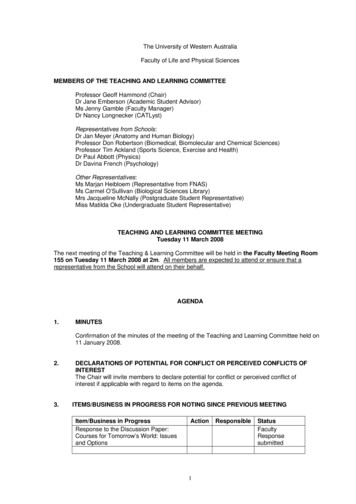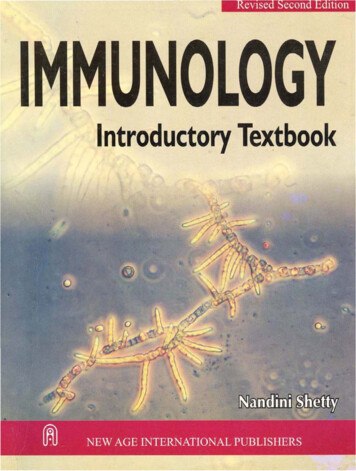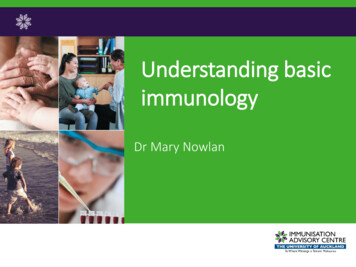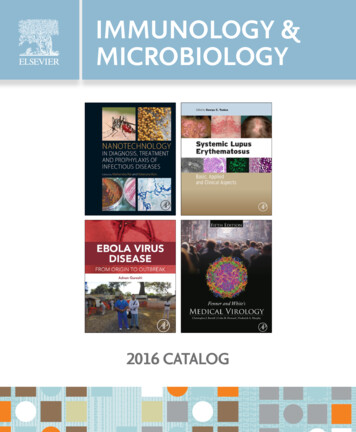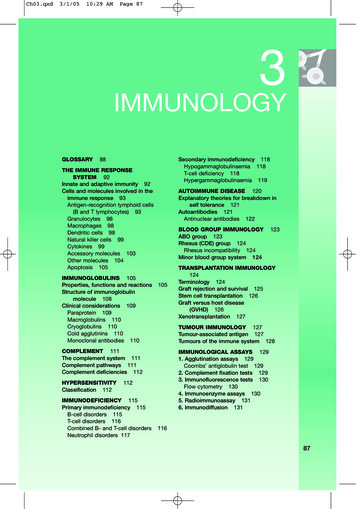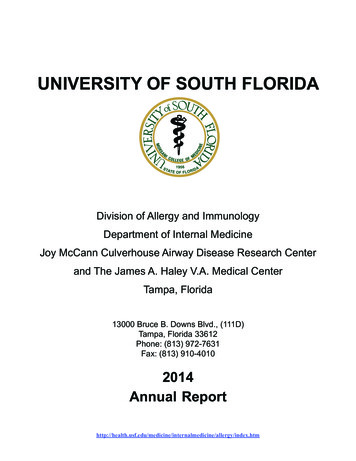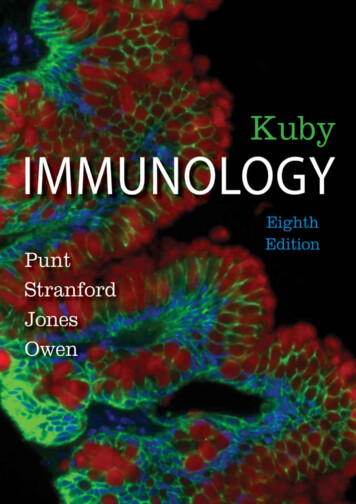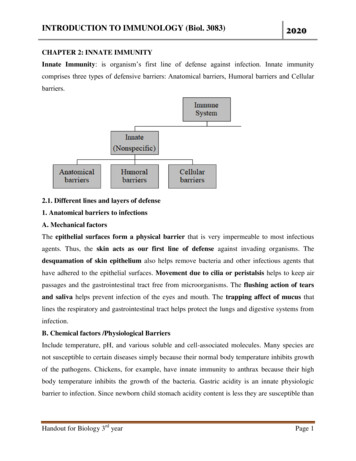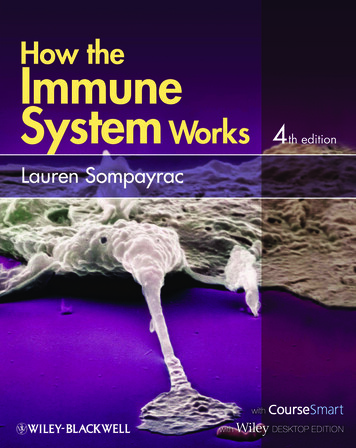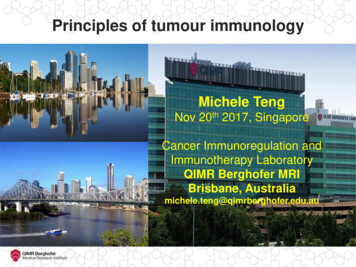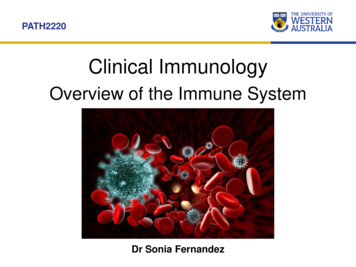
Transcription
PATH2220Clinical ImmunologyOverview of the Immune SystemDr Sonia Fernandez
The Spectrum of Clinical ologyPrimaryImmune ResponseSecondaryDeficiencyImmunodeficiencyLoss of ToleranceAutoimmunitySystemicHypersensitivityOrgan spec.IAllergyIIHaemolytic AnemiaIIIVasculitisIVTuberculosis
Some definitions Immunity– our ability to protect ourselves from disease– Recognition & removal of foreign material entering body– relies on our ability to distinguish between self and nonself– can be innate or acquired Immune system– the cells and molecules responsible for immunity andtheir collective and coordinated response to theintroduction of foreign substances (not just infectious) Immunology– study of cells, organs, molecules responsible forimmunity & how they respond & interact– effects & consequences (desirable/undesirable)– can the response be advantageously increased/reduced
The immune system deals with a variety of pathogens The immune system has evolved different methods to deal with the wide varietyof pathogens it has to deal with 2 key arms of the immune system are innate & adaptive immune responses
Two branches of the immune system
Time course of an immune response to viral infectionType I Interferon(Dendritic Cells)Natural Killer CellsCytotoxic T Lymphocytes
The Innate Immune System Why do we need innate immunity?– Microbes multiply at very high rates– Overwhelming infection can occur quickly– Need a system that detects infection rapidly Innate immunity is required to cover the timetaken (7-10 days) for adaptive immunity to begenerated Paramedics at an accident– React quickly & efficiently– Less specific actions than later “specialists”
Physical components of innate immunity Physical barrier between microbes inexternal environment and host tissue– skin & mucosal surfaces Multiple levels of physical protection– Tight junctions– Keratin– Mucus assisted by cilia & peristalsis Epithelial cells also produceantimicrobial chemicals– defensins– further impede entry of microbes Intraepithelial T cells recognise andrespond to a small number ofcommon microbial structures
Cellular components of innate immunity Macrophages – large phagocytic tissue cells, responsible forremoval of damaged tissue, cells, bacteria etc Neutrophils – short-lived scavenger blood cells containinggranules of powerful bactericidal enzymes (80%luekocytes) Dendritic cells – present antigen to T cells to initiateadaptive immune responses Natural Killer (NK) cells – lymphocyte-like cells capable ofkilling virus infected and tumor cells without the specificityof true lymphocytes Mast cells – found in tissues, release inflammatorymediators when damaged and under the influence of IgEantibody
Soluble components of innate immunity Several molecules that recognize/respond to microbes andpromote innate responses exist in soluble form in blood andECF Provide early defense against pathogens present outsidehost cells at some stage of their life cycle Function in two major ways– bind to microbes & act as opsonins to enhance phagocytosis bymacrophages, neutrophil & dendritic cells– promote inflammatory responses that bring more phagocytes to sitesof infections and may also directly kill microbes Complement, cytokines, chemokines, defensins, acute phaseproteins
Various components of innate immunitywork at different stages of infection Epithelial barriers impair microbial entry into thehost Resident and recruited phagocytes in subepithelialand other tissues provide protection if the barriersare breached Plasma proteins and circulating phagocytes provideprotection if microbes reach the blood stream
What does innate immunity recognise? Molecular structures that are produced by microbialpathogens – often shared by classes of microbes– Pathogen associated molecular patterns (PAMPs)– Essential for survival of microbes - ensures the target of the immuneresponse can’t just be discarded by the microbe to evade recognition Endogenous molecules that are produced by or releasedfrom damaged and dying cells– Damage associated molecular patterns (DAMPs)– Can be produced as a result of cell damage caused by infection– Also produced in response to sterile injury to cells chemical toxins, burns, trauma or low blood supply– generally not released by cells dying from apoptosis
Examples of PAMPs and DAMPs
How are PAMPs & DAMPs recognized? Pattern Recognition Receptors (PRR) Most cell types express PRR and are capable of participating in innateimmune responses Phagocytes & dendritic cells express the widest variety and greatestamount of these receptors in keeping with their fundamental roles Expressed on cell surfaces, in phagocytic vesicles and in the cytosol ofcells - all of which are locations where microbes may be present When these receptors bind PAMPs and DAMPs they activate signaltransduction pathways that promote antimicrobial and proinflammatoryfunctions of the cells in which they are expressed
Pattern Recognition Receptors
Effector mechanisms of innate immunity Inflammation– the process by which leukocytes and circulating plasmaproteins are brought into sites of infection and activatedto destroy and eliminate the offending agents– also the major reaction to damaged or dead cells and toaccumulations of abnormal substances in cells andtissues Anti-viral defense– consists of changes in cells that prevent virus replicationand increase susceptibility
Phagocytosis and intracellular destruction of microbes
Effector functions of macrophages
Anti-viral actions of type I interferons
Effector functions of NK cells
Stimulation of adaptive immunity
The Adaptive Immune System Key cells are T and B lymphocytes Lymphocytes express highly diverse membrane receptors– Recognise a wide variety of foreign substances– Distinguish subtle differences in structure– Receptors generated by rearrangement of antigen receptor genes duringthe development of mature B and T cells from precursor cells Provides diversity –can respond to a large variety of antigenswhich is essential to defend against the many potentialpathogens in the environment Takes about a week to develop but then provides long-termmemory which ensure a faster, better response when nextencountering the same pathogen
Types of adaptive immunity Humoral immunity– Mediated by secreted antibodies– Defense against extracellularmicrobes– Antibodies recognise microbialantigens, neutralise their infectivityand target microbes for elimination– Antibodies are specialised activate different effectorfunctions Cell-mediated immunity– Mediated by T cells themselves &their products (cytokines)– Defense against intracellularmicrobes
Phases of adaptive immune responses
How are T cells activated? They need to recognisethe foreign pathogen T-cells can not directly“see” microbes - onlyrecognise antigens (shortpeptides) that arepresented on the surfaceof host cells– Infected cells– Antigen presenting cells They need a second costimulatory signal– Binding of B7 to CD28APCT cell
How do T cells recognise antigen?APCMHC class IIpresent peptides toCD4 T-cellsT cellMHC class Ipresent peptides toCD8 T-cells
Antigen Presenting Cells
T cell subsets
Effector CD4 T cell Subsets Express surface molecules and secrete cytokines Activate other cells Distinct subsets arise in response to different antigens
Functions of Th1 CellsActivate macrophages to ingest and destroy internalised microbesIFN-γExtracellular antigens(e.g. bacteria) usuallyend up in endosomalvesiclesT cellrecognition ofpeptide-MHC-IIcomplex
Functions of Th2 CellsStimulate reactionsthat serve toeradicate helminthicinfectionsIL-4 induces IgEantibody responsesIL-5 activateseosinophilesIL-13 has diversefunctions
Functions of Th17 CellsSecrete cytokines thatrecruit neutrophils to sitesof infectionNeutrophils are a majordefense mechanismagainst extracellularbacteria and fungi
Cytotoxic T-cell responsesEliminate intracellular microbes mainly by killing infected cellsGranzyme &PerforinEndogenouslysynthesizedantigens innucleated cell(viral or tumor)Recognisepeptide-MHC-Icomplex
Treg suppress immune responses
How are B cells activated? Recognise antigen in its intact, nativeconformation and do not requireantigen to be processed by APC orpresented in MHC molecules Antibody molecules expressed on thesurface of the B cell act as the B cellreceptor (BCR) Secondary signals promote increasedactivation and signalling Once activated, B cells differentiate intoplasma cells that secrete antibodymolecules
How are B cells activated? Antibodies exist as different isotypes They have different functions at different locations and fordifferent pathogens IgM is the first Ab made, switch to IgG and others later in theresponse
Functions of antibodies
NeutralisationA. Antibodies preventthe binding of microbesto cells and so inhibitinfection of host cells.B. Antibodies inhibit thespread of microbesfrom an infected cell toadjacent uninfectedcells.C. Antibodies block thebinding of toxins to cellsand thus inhibit thepathologic effects of thetoxins.
Opsonisation Antibodies of certain IgG subclasses bind to microbes and are thenrecognized by Fc receptors on phagocytes. Signals from the Fc receptors promote the phagocytosis of the opsonizedmicrobes and activate the phagocytes to destroy these microbes.
Specificity, memory and contraction ofadaptive immune responses
ToleranceCentral Tolerancemechanism by whichimmature T cells thatrecognise self antigens aredeleted during developmentin the thymus, sometimesreferred to as “thymiceducation”Peripheral Tolerancemechanism by which matureT cells that recognise selfantigens in peripheral tissuesare rendered incapable ofsubsequently responding tothose antigens
The Spectrum of Clinical ologyPrimaryImmune ResponseSecondaryDeficiencyImmunodeficiencyLoss of ToleranceAutoimmunitySystemicHypersensitivityOrgan spec.IAllergyIIHaemolytic AnemiaIIIVasculitisIVTuberculosis
Immunology –study of cells, organs, molecules responsible for immunity & how they respond & interact –effects & consequences (desirable/undesirable) –can the response be advantageously increased/reduc
